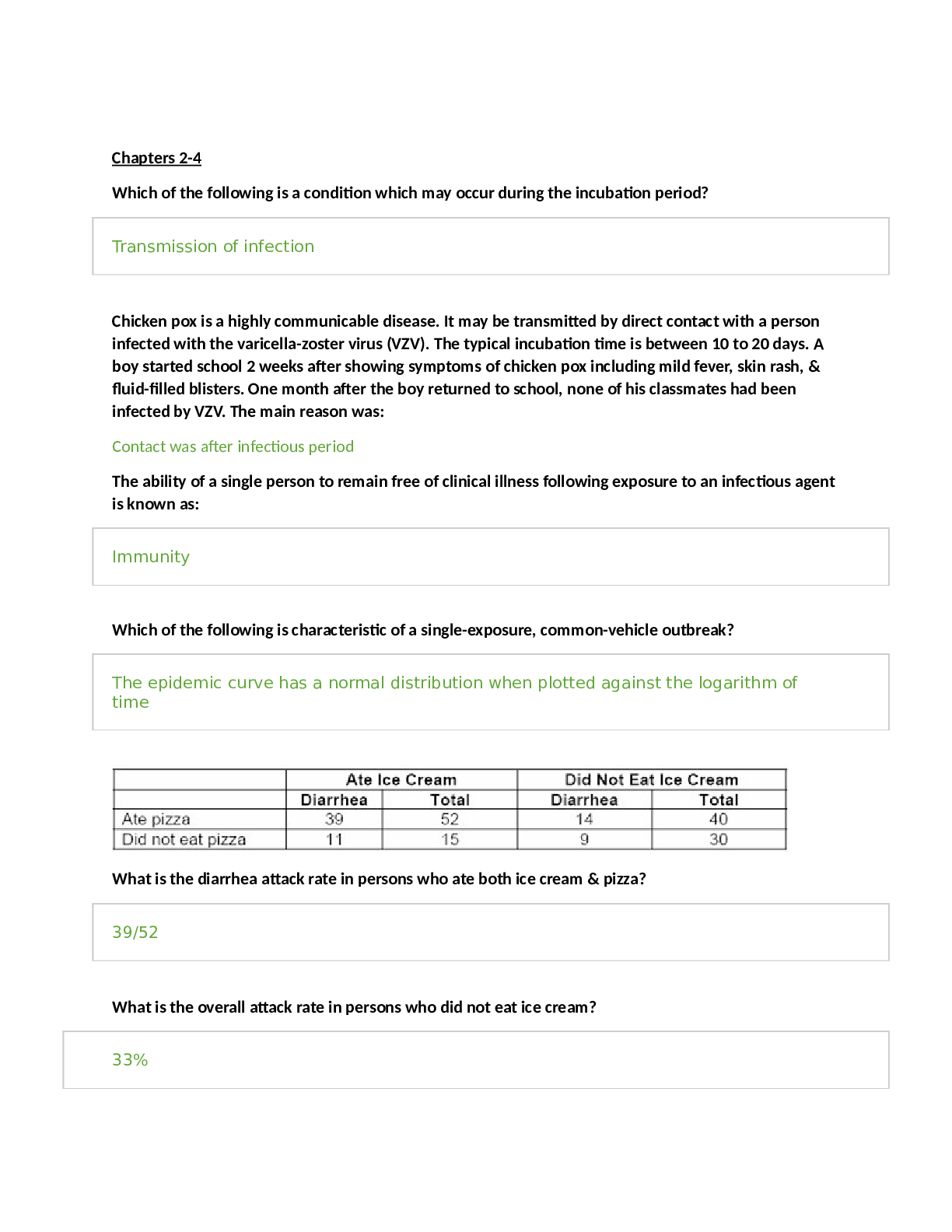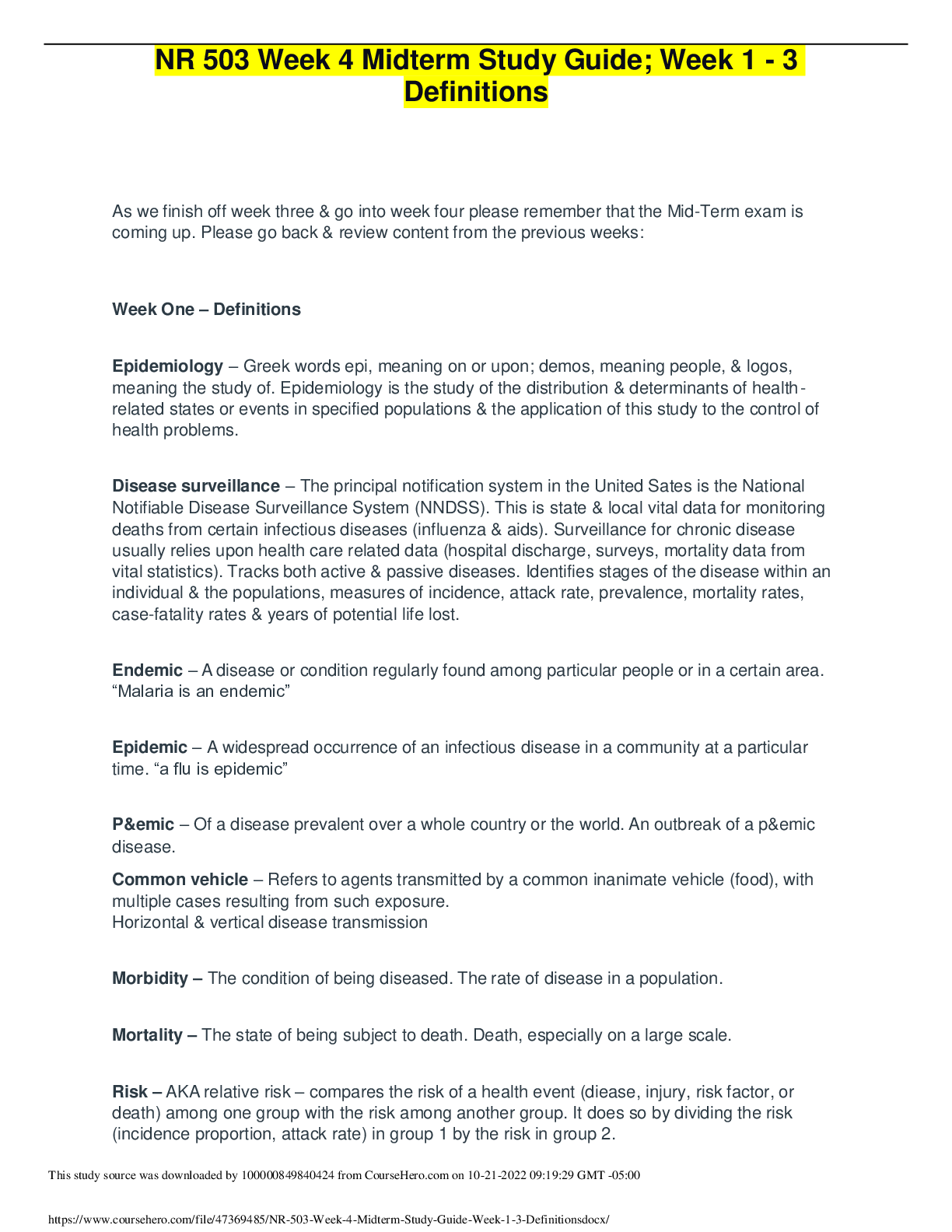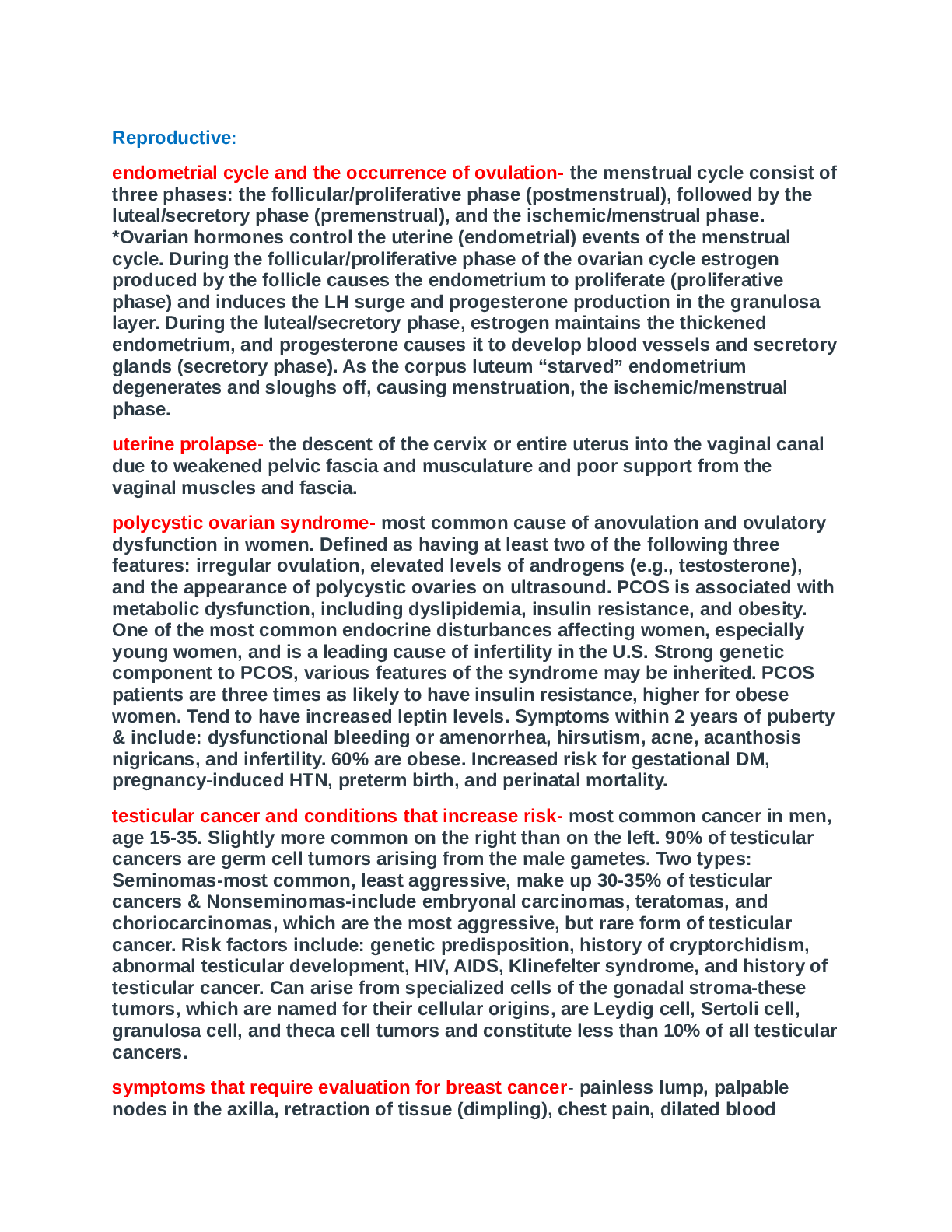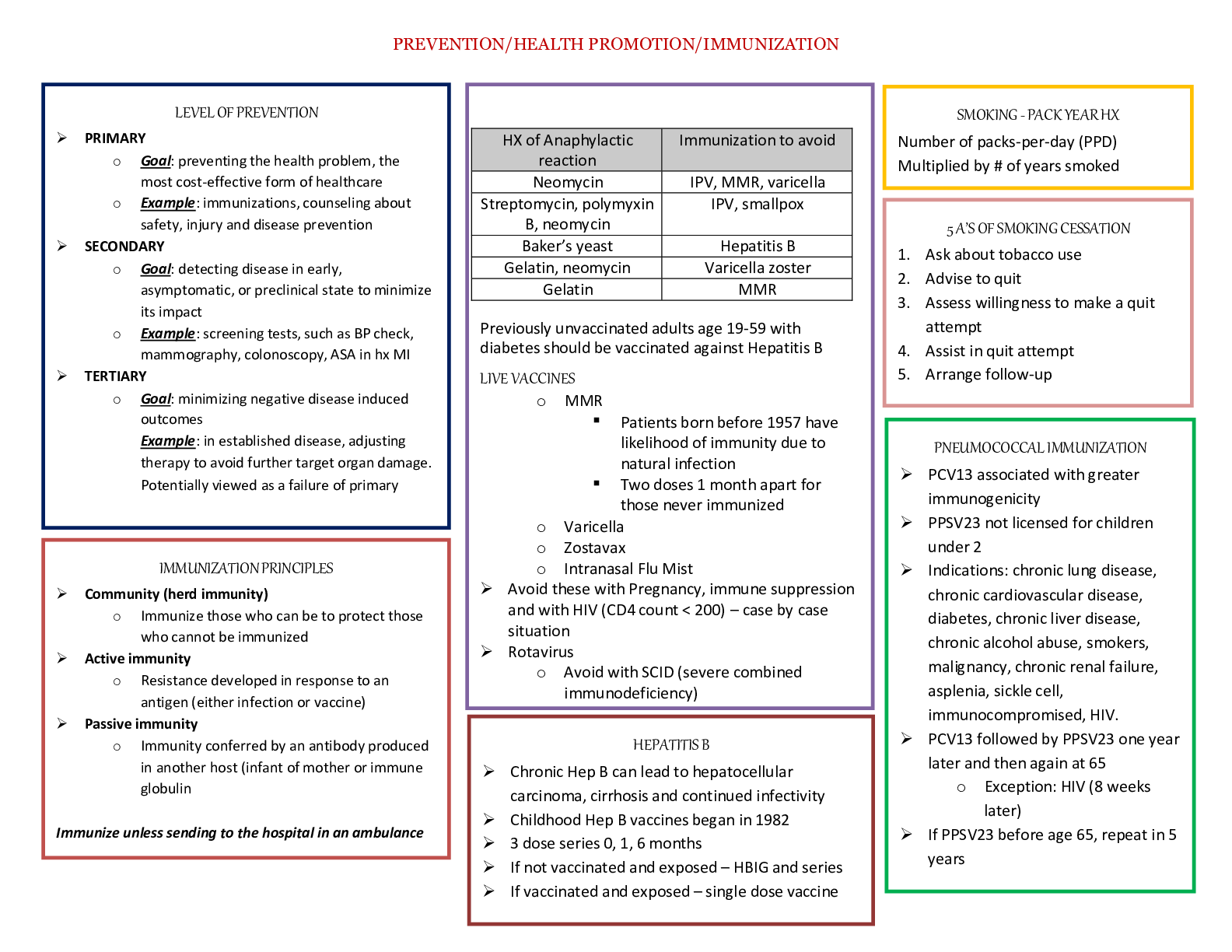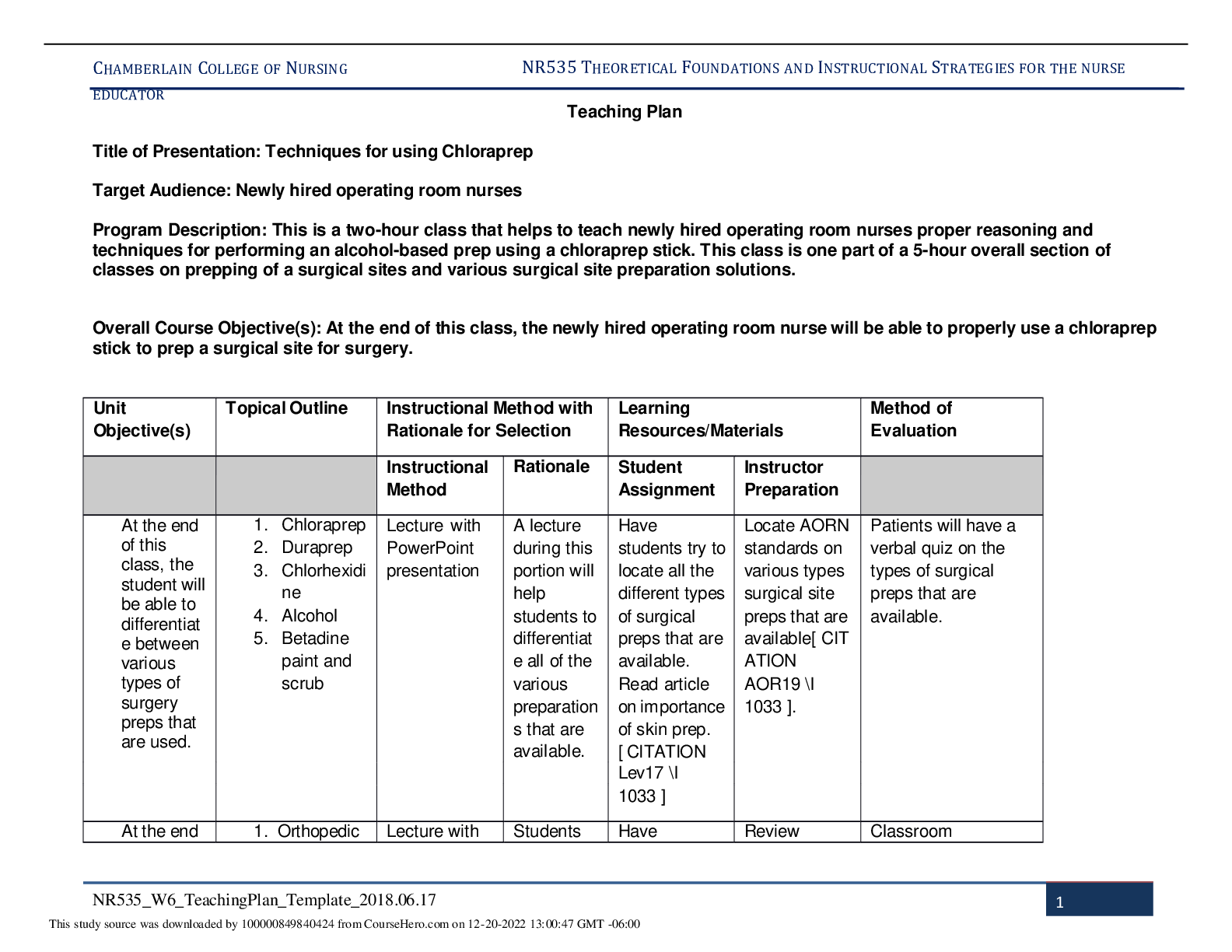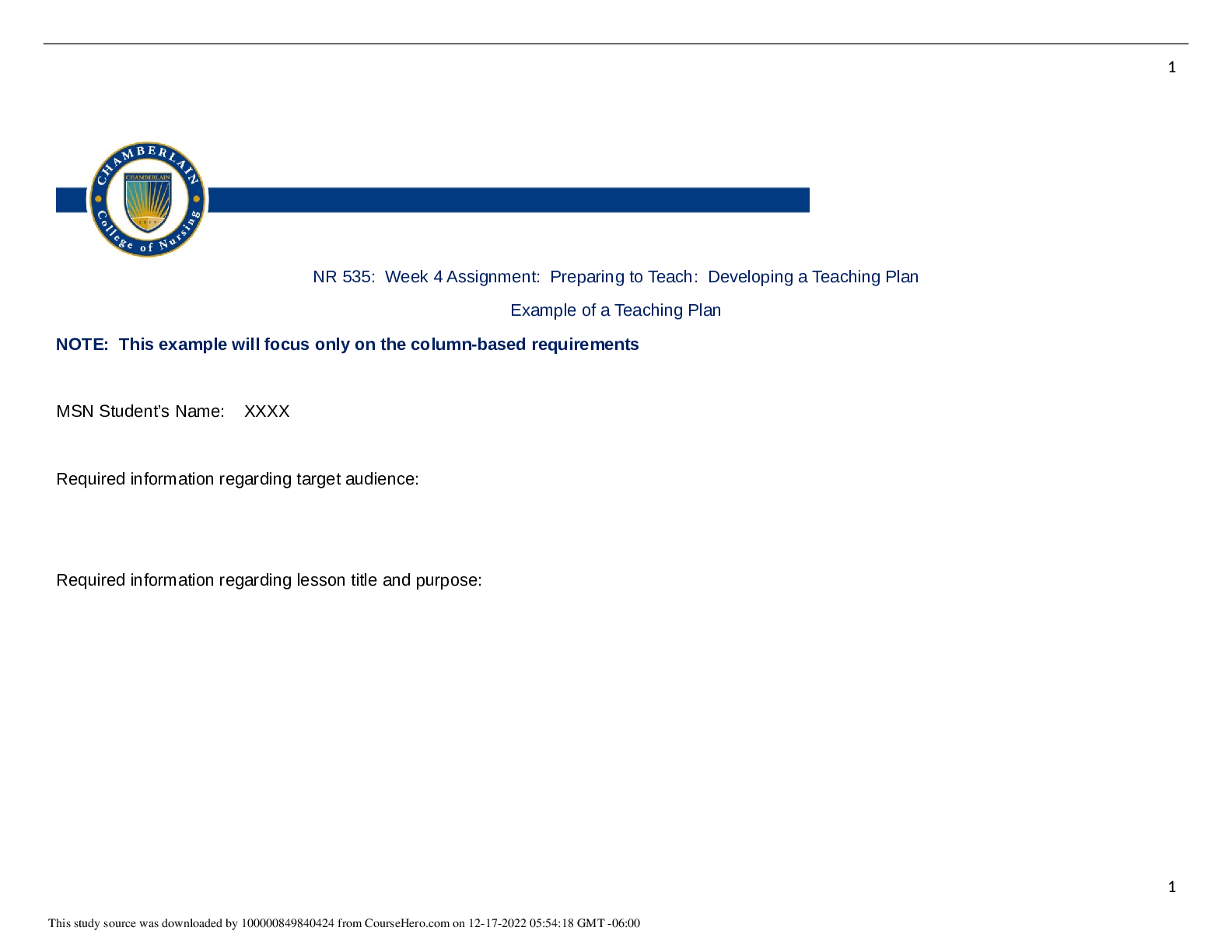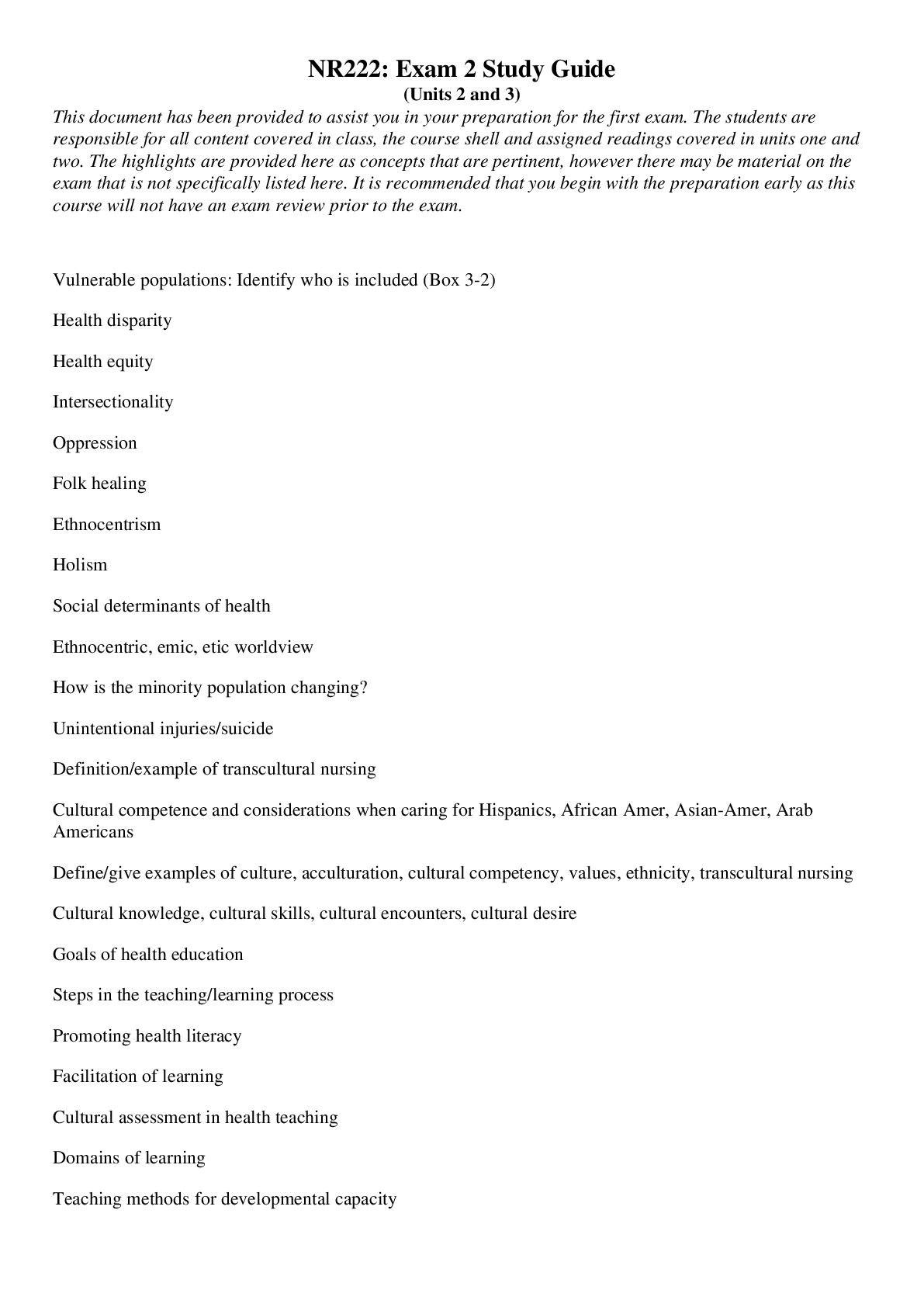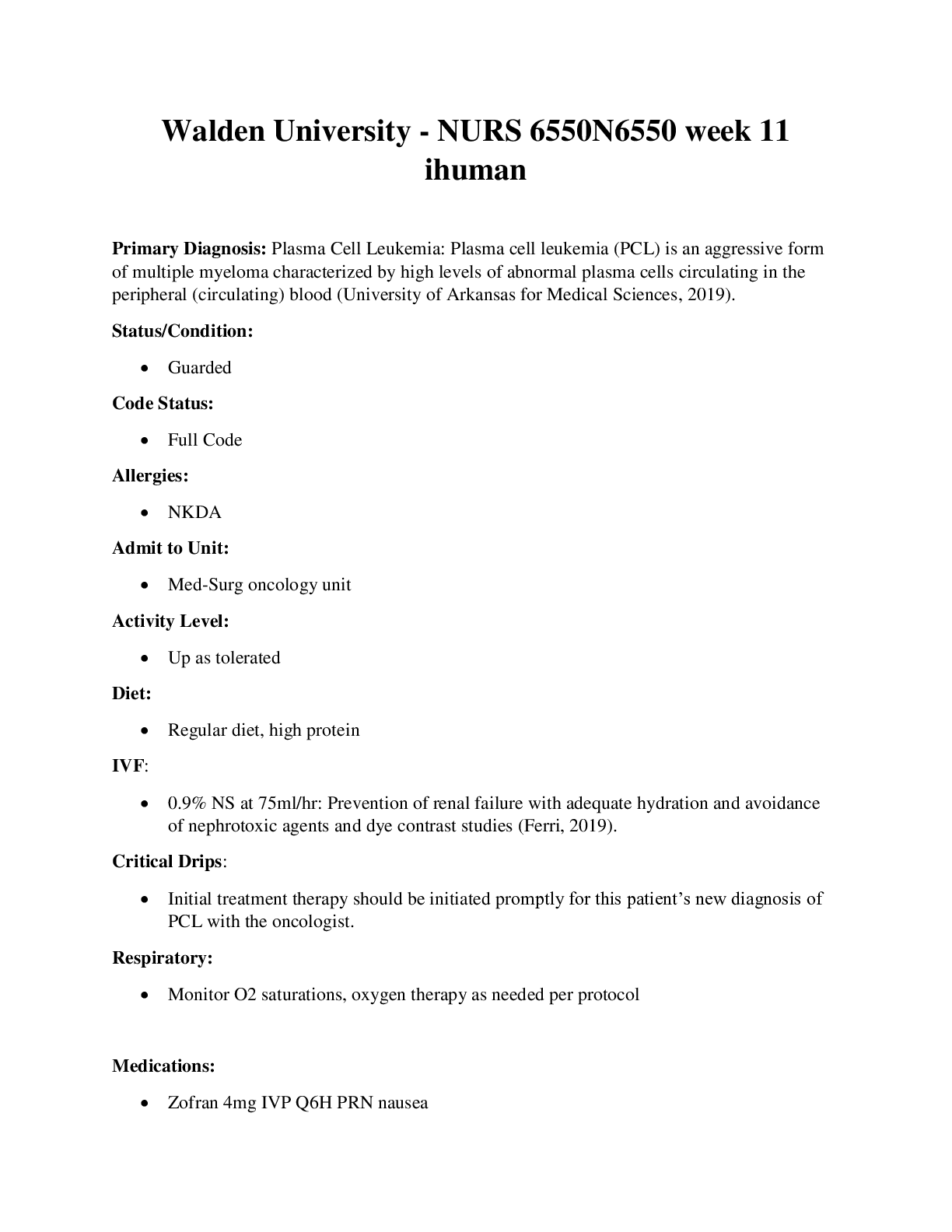*NURSING > STUDY GUIDE > NURSING 1214 Fluid and electrolyte Study Guide | 100% Guaranteed Pass. (All)
NURSING 1214 Fluid and electrolyte Study Guide | 100% Guaranteed Pass.
Document Content and Description Below
Fluid and electrolyte Fluid and electrolyte balance is a dynamic process that is crucial for life and homeostasis. • Fluid occupies almost 60% of the weight of an adult. • Body fluid is l... ocated in two fluid compartments: the intracellular space and the extracellular space. • Electrolytes in body fluids are active chemicals or cations that carry positive charges and anions that carry negative charges. • The major cations in the body fluid are sodium, potassium, calcium, magnesium, and hydrogen ions. • The major anions are chloride, bicarbonate, sulfate, and proteinate ions. Homeostasis Homeostasis is the dynamic process in which the body maintains balance by constantly adjusting to internal and external stimuli. Negative and Positive Feedback • Feedback is the relaying of information about a given condition to the appropriate organ or system. • Negative feedback. Negative feedback occurs when the body reverses an original stimulus for the body to regain physiologic balance. • Positive feedback. Positive feedback enhances or intensifies the original stimulus. • Examples. Blood pressure control and maintenance of normal body temperature are examples of negative feedback while blood clotting after an injury and a woman in laborare examples of positive feedback. Systems Involved in Feedback The major systems involved in feedback are the nervous and endocrine systems. • Nervous system. The nervous system regulates homeostasis by sensing system deviations and sending nerve impulses to appropriate organs. • Endocrine system. The endocrine system uses the release and action of hormones to maintain homeostasis. Body Fluids Fluids make up a large portion of the body, which is approximately 50%-60% of the total body weight. Location of Fluids • Main compartments. Body fluids are divided between two main compartments: the intracellular fluid and the extracellular fluid compartments. • Intracellular fluid. Intracellular fluid functions as a stabilizing agent for the parts of the cell, helps maintain cell shape, and assists with transport of nutrients across the cell membrane, in and out of the cell. • Extracellular fluid. Extracellular fluid mostly appears as interstitial tissue fluid and intravascular fluid. Fluid Regulation Mechanisms • The thirst center. The thirst center in the hypothalamus stimulates or inhibits the desire for a person to drink. • Antidiuretic hormone. ADH regulates the amount of water the kidney tubules absorb and is released in response to low blood volume or in response to an increase in concentration of sodium and other solutes in the intravascular fluids. • The RAA system. The RAA system controls fluid volume, in which when the blood volume decreases, blood flow to the renal juxtaglomerular apparatus is reduced, thereby activating the RAA system. • Atrial natriuretic peptide. The heart also plays a role in correcting overload imbalances, by releasing ANP from the right atrium. Normal Intake and Output • Daily intake. An adult human at rest takes appropriately 2,500 ml of fluid daily. • Levels of intake. Approximate levels of intake include fluids 1, 200 ml, foods 1, 000 ml, and metabolic products 30 ml. • Daily output. Daily output should approximately equal in intake. • Normal output. Normal output occurs as urine, breathing, perspiration, feces, and in minimal amounts of vaginal secretions. Overhydration and Edema • Overhydration. Overhydration is an excess of water in the body. • Edema. Edema is the excess accumulation of fluid in interstitial tissue spaces, also called third-space fluid. • Cause of edema. Edema is caused by a disruption of the filtration and osmotic forces of the body’s circulating fluids. • Treatment of edema. Diuretics are commonly given for systemic edema. Dehydration • Dehydration. Dehydration is a deficiency of body water or excessive loss of water. • External causes. External causes of dehydration include prolonged sun exposure and excessive exercise, as well as diarrhea, vomiting, and burns. • Treatment of dehydration. Supplemental fluids and electrolytes are often administered. Electrolytes An electrolyte is a substance that will disassociate into ions when dissolved in water. • Origins. Electrolytes are found in the form of inorganic salts, acids, and bases. • Active chemicals. Electrolyte concentrations are measured according to their chemical activity and expressed as milliequivalents. • Ions. Each chemical element has an electrical charge, either positive or negative. • Intracellular electrolytes. Important intracellular electrolytes are potassium, magnesium, sulfate, and phosphate, and the most dominant cation iss potassium while the most dominant anion is phosphate. • Extracellular electrolytes. Important extracellular electrolytes include sodium, chlorine, calcium, and bicarbonate, and the most essential cation is sodium while chlorine is the most important anion. Fluid and Electrolyte Transport Total electrolyte concentration affects the body’s fluid balance. • The body cells. Nutrients and oxygen should enter body cells while waste products should exit the body. • The cell membrane. The cell membrane separates the intracellular environment from the extracellular environment. • Permeability. The ability of a membrane to allow molecules to pass through is known as permeability. Permeability of Membranes • Freely permeable membranes. These membranes allow almost any food or waste substance to pass through. • Selectively permeable. The cell membrane is selectively permeable, meaning that each cell’s membrane allows only certain specific substances to pass through. Passive Transport • Passive transport. Passive transport mechanisms include diffusion, osmosis, and filtration. • Diffusion. Diffusion, or the process of “being widely spread”, is the random movement of molecules from an area of higher concentration to an area of lower concentration. • Osmosis. Osmosis is the diffusion of a pure solvent, such as water, across a semipermeable membrane in response to a concentration gradient in situations where the molecules of a higher concentration are non diffusible. • Filtration. Filtration is the transport of water and dissolved materials concentration already exists in the cell. Active Transport • Mechanisms. Active transport mechanisms require specific enzymes and an energy expenditure in the form of adenosine triphosphate (ATP). • Processes. Active transport processes can move solutes “uphill”, against the normal rules of concentration and pressure. Fluid and Electrolyte Balance Fluid and electrolyte balance is vital for proper functioning of all body systems. • Osmolarity. This is the property of particles in a solution to dissociate into ions. • Electroneutrality. This is the balance of positive and negative charges. Classification There are different fluid volume disturbances that may affect an individual. • Fluid volume deficit or hypovolemia occurs when loss of ECF volume exceeds the intake of fluid. • Fluid volume excess or hypervolemia refers to an isotonic volume expansion of the ECF caused by the abnormal retention of water and sodium in approximately the same proportions in which they normally exist in the ECF. Disturbances in electrolyte balances are common in clinical practice and must be corrected. • Hyponatremia refers to a serum sodium level that is less than 135 mEq/L • Hypernatremia is a serum sodium level higher than 145 mEq/L. • Hypokalemia usually indicates a deficit in total potassium stores. • Hyperkalemia refers to a potassium level greater than 5.0 mEq/L. • Hypocalcemia are serum levels below 8.6 mg/dl. • Hypercalcemia is calcium level greater than 10.2 mg/dl. • Hypomagnesemia refers to a below- normal serum magnesium concentration. • Hypermagnesemia are serum levels over 2.3 mg/dl. • Hypophosphatemia is indicated by a value below 2.5 mg/dl. • Hyperphosphatemia is a serum phosphorus level that exceeds 4.5 mg/dl in adults. Pathophysiology Nurses need an understanding of the pathophysiology of fluid and electrolyte balance to anticipate, identify, and respond to possible imbalances. • Concentrations. Electrolyte concentrations vary from those in the ICF to those in the ECF. • Sodium. Sodium ions outnumber any other cations in the ECF; therefore it is essential in the fluid regulation of the body. • Potassium. The ECF has a low concentration of potassium and can tolerate only small changes in its concentrations. • Maintenance. The body expends a great deal of energy in maintaining the sodium and potassium concentrations through cell membrane pumps that exchange sodium and potassium ions. • Osmosis. When two different solutions are separated by a membrane that is impermeable to the dissolved substances, fluid shifts from the region of low solute concentration to the high solute concentration until the solutions are of equal concentrations. • Diffusion. Diffusion is the natural tendency of a substance to move in an area of higher concentration to an area of lower concentration. Causes Causes of fluid and electrolyte imbalances are discussed below in general. • Fluid retention. Retention of sodium is associated with fluid retention. • Loss of sodium. Excessive loss of sodium is associated with decreased volume of body fluid. • Trauma. Trauma causes release of intracellular potassium which is extremely dangerous. • Loss of body fluids. FVD results from loss of body fluids and occurs more rapidly when coupled with decreased fluid intake. • Fluid overload. Fluid volume excess may be related to a simple fluid overload or diminished function of the homeostatic mechanisms responsible for regulating fluid balance. • Low or high electrolyte intake. Diets low or excessive in electrolytes could also cause electrolyte imbalances. • Medications. There are certain medications that could lead to electrolyte imbalances when taken against the physician’s orders. Clinical Manifestations Signs and symptoms that occur in fluid and electrolyte imbalances are discussed below. • Fluid volume deficit. Clinical signs and symptoms include acute weight loss, decreased skin turgor, oliguria, concentrated urine, orthostatic hypotension, a weak, rapid heart rate, flattened neck veins, increased temperature, thirst, decreased or delayed capillary refill, cool, clammy skin, muscle weakness, and cramps. • Fluid volume excess. Clinical manifestations for FVE include edema, distended neck veins, and crackles. • Hyponatremia. Signs and symptoms include anorexia, nausea and vomiting, headache, lethargy, dizziness, confusion, muscle cramps and weakness, muscular twitching, seizures, dry skin, and edema. • Hypernatremia. The signs and symptoms are thirst, elevated body temperature, hallucinations, lethargy, restlessness, pulmonary edema, twitching, increased BP and pulse. • Hypokalemia. Clinical manifestations are fatigue, anorexia, muscle weakness, polyuria, decreased bowel motility, paresthesia, ileus, abdominal distention, and hypoactive reflexes • Hyperkalemia. Signs and symptoms include muscle weakness, tachycardia, paresthesia, dysrhythmias, intestinal colic, cramps, abdominal distention, and anxiety. • Hypocalcemia. The signs and symptoms are numbness, tingling of fingers, toes, and circumoral region, positive Trousseau’s sign and Chvostek’s sign, seizures, hyperactive deep tendon reflexes, irritability, and bronchospasm. • Hypercalcemia. The signs and symptoms include muscle weakness, constipation, anorexia, nausea and vomiting, dehydration, hypoactive deep tendon reflexes lethargy, calcium stones, flank pain, pathologic fractures, and deep bone pain. • Hypomagnesemia. Clinical manifestations include neuromuscular irritability, positive Trousseau’s and Chvostek’s sign, insomnia, mood changes, anorexia, vomiting, and increased deep tendon reflexes. • Hypermagnesemia. Signs and symptoms are flushing, hypotension, muscle weakness, drowsiness, hypoactive reflexes, depressed respirations, and diaphoresis. • Hypophosphatemia. Signs and symptoms include paresthesias, muscle weakness, bone pain and tenderness, chest pain, confusion, seizures, tissue hypoxia, and nystagmus. • Hyperphosphatemia. Clinical manifestations are tetany, tachycardia, anorexia, nausea and vomiting, muscle weakness, and hyperactive reflexes. Complications Fluid and electrolyte imbalances could result in complications if not treated promptly. • Dehydration. Fluid volume deficit could result in dehydration of the body tissues. • Cardiac overload. Fluid volume excess could result in cardiac overload if left untreated. • SIADH. Water is retained abnormally in SIADH. • Cardiac arrest. Too much potassium administered could lead to cardiac arrest. Assessment and Diagnostic Findings The following are laboratory studies useful in diagnosing fluid and electrolyte imbalances: • BUN. BUN may be decreased in FVE due to plasma dilution. • Hematocrit. Hematocrit levels in FVD are greater than normal because there is a decreased plasma volume. • Physical examination. Physical exam is necessary to observe the signs and symptoms of the imbalances. • Serum electrolyte levels. Measurement of electrolyte levels should be performed to check for presence of an imbalance. • ECG. ECG changes can also contribute to the diagnosis of fluid and electrolyte imbalance. • ABG analysis. ABG analysis may reveal acid-base imbalances. Medical Management Treatment of fluid and volume imbalances needs accuracy to avoid consequences that can result in complications. • Isotonic electrolyte solutions. These solutions are used to treat the hypotensive patient with FVD because they expand plasma volume. • Accurate I&O. Accurate and frequent assessments of I&O should be performed when therapy should be slowed or increased to prevent volume deficit or overload. • Dialysis. Hemodialysis or peritoneal dialysis is performed to remove nitrogenous wastes and control potassium and acid-base balance, and to remove sodium and fluid. • Nutritional therapy. Treatment of fluid and electrolyte imbalances should involve restrictions or enforcement of the concerned electrolyte. Pharmacologic therapy • AVP receptor agonists. These are new pharmacologic agents that treat hyponatremiaby stimulating free water excretion. • Diuretics. To decrease fluid volume in FVE, diuretics are administered. • IV calcium gluconate. If serum potassium levels are dangerously elevated, it may be necessary to administer IV calcium gluconate. • Calcitonin. Calcitonin can be used to lower the serum calcium level and is particularly useful for patients with heart disease or heart failure who cannot tolerate large sodium loads. Nursing Management Nurses may use effective teaching and communication skills to help prevent and treat various fluid and electrolyte disturbances. Nursing Assessment Close monitoring should be done for patients with fluid and electrolyte imbalances. • I&O. the nurse should monitor for fluid I&O at least every 8 hours, or even hourly. • Daily weight. Assess the patient’s weight daily to measure any gains or losses. • Vital signs. Vital signs should be closely monitored. • Physical exam. Physical exam is needed to reinforce other data about a fluid or electrolyte imbalance. Diagnosis The following diagnoses are found in patients with fluid and electrolyte imbalances. • Excess fluid volume related to excess fluid intake and sodium intake. • Deficient fluid volume related to active fluid loss or failure of regulatory mechanisms. • Imbalanced nutrition: less than body requirements related to inability to ingest food or absorb nutrients. • Imbalanced nutrition: more than body requirements related to excessive intake. • Diarrhea related to adverse effects of medications or malabsorption. Nursing Care Planning & Goals Main Article: 10 Fluid And Electrolyte Imbalances Nursing Care Plans Planning and goals for fluid and electrolyte imbalances include: • Maintenance of fluid volume at a functional level. • Display of normal laboratory values. • Demonstration appropriate changes in lifestyle and behaviors including eating patterns and food quantity/quality. • Reestablishment and maintenance of normal pattern and GI functioning. Nursing Interventions There are specific nursing interventions for fluid and electrolyte imbalances that can aid in alleviating the patient’s condition. • Monitor turgor. Skin and tongue turgor are indicators of the fluid status of the patient. • Urine concentration. Obtain urine sample of the patient to check for urineconcentration. • Oral and parenteral fluids. Administer oral or parenteral fluids as indicated to correct the deficit. • Oral rehydration solutions. These solutions provide fluid, glucose, and electrolytes in concentrations that are easily absorbed. • Central nervous system changes. The nurse must be alert for central nervous systemchanges such as lethargy, seizures, confusion, and muscle twitching. • Diet. The nurse must encourage intake of electrolytes that are deficient or restrict intake if the electrolyte levels are excessive. Evaluation Evaluation of the care plan can check the effectiveness of the treatments. The interventions are deemed effective if the client has: • Maintained fluid volume at a functional level. • Displayed normal laboratory results. • Demonstrated appropriate changes in lifestyle and behaviors including eating patterns and food quantity/quality. • Reestablished and maintained normal pattern and GI functioning. Discharge and Home Care Guidelines After hospitalization, treatment and maintenance of the condition must continue at home. • Diet. A diet rich in all the nutrients and electrolytes that a person needs should be enforced. • Fluid intake. Fluid intake must take shape according to the recommendations of the physician. • Follow-up. A week after discharge, the patient must return for a follow-up checkup for evaluation of electrolyte and fluid status. • Medications. Compliance to prescribed medications should be strict to avoid recurrence of the condition. Documentation Guidelines Data should be documented for future medical and legal references. The nurse must document: • Individual findings, including factors affecting ability to manage body fluids and degree of deficit. • I&O, fluid balance, changes in weight, urine specific gravity, and vital signs. • Results of diagnostic testing and laboratory studies. • Plan of care. • Client’s responses to treatment, teaching, and actions performed. • Attainment or progress toward desired outcome. • Modifications to plan of care. ECF is primarily composed of: Interstitial and intravascular fluids. Water moves across a semipermeable membrane via which process? Osmosis To balance water output, an average adult must have daily fluid intake of approximately: 2,000-3,000 ml. The primary organs involved in pH regulation are: Skin and kidneys. A clinical manifestation not found in hypokalemia is: Oliguria Polyuria is present in hypokalemia instead of oliguria. The nurse should expect that a patient with mild fluid volume excess would be prescribed a diuretic that blocks sodium reabsorption in the distal tubule, such as: Lasix Nursing intervention for a patient with a diagnosis of hyponatremia includes all of the following except: Encouraging the intake of low-sodium liquids such as coffee or tea. To supplement a diet with foods rich in potassium, the nurse should recommend the addition of: Fruits such as bananas and apricots The most characteristic manifestation of hypocalcemia and hypomagnesemia is: Tetany Decreased levels of calcium and magnesium leads to tetany. A: Anorexia is a manifestation of hypomagnesemia while nausea is a sign of hypercalcemia. B: Constipation is not a manifestation of hypocalcemia or hypomagnesemia. C: Lack of coordination is not a manifestation of hypocalcemia or hypomagnesemia. The adrenal glands secrete what hormone? Aldosterone-Sodium retention (consequently causing water retention), and potassium excretion. The parathyroid glands regulate which electrolytes? Calcium and phosphorus The pituitary gland secretes which hormone? ADH (which causes water retention) The kidneys regulate pH by excreting or maintaining which elements?Hydrogen ions and bicarbonate Low potassium levels are often accompanied by what? Low magnesium levels Blood product administration requires at least what gauge needle size? At least a 19-gauge or larger Fluid volume deficit occurs when? The body loses water and electrolytes in equal proportion as existing in normal body fluids; Serum electrolyte levels stay normal Dehydration occurs when? The body loses water, but serum sodium levels increase One liter of fluid weight loss or gain is approx. equal to? 2.2 pounds or 1 kilogram Fluid volume deficit can be observed in which lab findings?Elevated BUN and creatinine, Increased serum osmolality, Elevated hemoglobin and hematocrit (think concentration) Water is what of osmotic fluid? Hypotonic What are some nursing care interventions for fluid volume deficit? Strict I&Os, Replacement of fluids ISOTONICALLY, preferably PO If IV hydration is needed, isotonic fluids are used Fluid volume excess occurs when? The body retains excess water and electrolytes isotonically Water intoxication occurs when? The body retains excess water, and serum sodium levels decrease in proportion to the retained water What are some nursing care interventions for fluid volume excess? Diuretics, Fluid restriction, Strict I&Os, Na restriction, Daily weights, Serum potassium monitoring Fluid volume excess can be observed in which lab findings? Decreased BUN, decreased hemoglobin and hematocrit, decreased serum osmolality, decreased urine osmolality and specific gravity. How long do you hold pressure on a site after IV removal? 1 to 3 minutes at least IV sites should be accessed by the nurse at least? A minimum of every two hours Flat T waves on an EKG is a sign of? Hypokalemia What electrolyte is never given IV bolus? Potassium (irritating to both GI tract and to veins; dilute in both situations before administering) What are some foods that are high in K? Spinach, bananas, cantaloupe, avocados, oranges, and potatoes When looking at a patient’s labs for potassium imbalances always make sure that the serum sample was ? Hemolyzed Hyperkalemia is associated with what finding on an EKG? Tall T waves What are some nursing interventions for hyperkalemia? Remove parenteral K from IV infusions and medications, Adm. 50% glucose with regular insulin, Adm. Kayexalate and monitor EKG, Adm. calcium gluconate to protect the heart, IV loop diuretics or renal dialysis may be required Trousseau's sign is associated with what electrolyte imbalance? Hypocalcemia What are some nursing interventions for hypocalcemia? Adm. Ca supplements 30 minutes before meals, Adm. Ca IV slowly because infiltration can cause tissue necrosis, Increase calcium intake in diet (dairy products, greens) What are some signs of hypocalcemia? Diarrhea, Numbness, Tingling of the extremities, Convulsions, Positive Trousseau's sign (at risk for tetany) What are some nursing interventions for hypercalcemia? remove parenteral calcium, Adm. calcitonin to reduce Ca, Avoid Ca based antacids, Renal dialysis may be required Fluctuations in calcium usually have similar fluctuations as which other electrolyte? Magnesium The nurse is caring for a client with heart failure. On assessment, the nurse notes that the client is dyspneic, and crackles are audible on auscultation. What additional manifestations would the nurse expect to note in this client if excess fluid volume is present? An increase in blood pressure and increased respirations The nurse is preparing to care for a client with a potassium deficit. The nurse reviews the client's record and determines that the client is at risk for developing the potassium deficit because of which situation? Requires nasogastric suction The nurse reviews a client's electrolyte laboratory report and notes that the potassium level is 2.5 mEq/L (2.5 mmol/L). Which patterns should the nurse watch for on the electrocardiogram (ECG) as a result of the laboratory value? Select all that apply. U waves, Inverted T waves, Depressed ST segment The nurse provides instructions to a client with a low potassium level about the foods that are high in potassium and tells the client to consume which foods? Raisins Potatoes Cantaloupe Strawberries The nurse is reviewing laboratory results and notes that a client's serum sodium level is 150 mEq/L (150 mmol/L). The nurse reports the serum sodium level to the health care provider (HCP) and the HCP prescribes dietary instructions based on the sodium level. Which acceptable food items does the nurse instruct the client to consume? Peas Nuts Cauliflower. They are Low Sodium The nurse is assessing a client with a suspected diagnosis of hypocalcemia. Which clinical manifestation would the nurse expect to note in the client? Twitching The nurse is caring for a client with hypocalcemia. Which patterns would the nurse watch for on the electrocardiogram as a result of the laboratory value? Prolonged QT interval Prolonged ST segment The nurse reviews the electrolyte results of an assigned client and notes that the potassium level is 5.7 mEq/L (5.7 mmol/L). Which patterns would the nurse watch for on the cardiac monitor as a result of the laboratory value? Tall peaked T waves. Widened QRS complexes Which client is at risk for the development of a sodium level at 130 mEq/L (130 mmol/L)? The client who is taking diuretics The nurse is caring for a client with heart failure who is receiving high doses of a diuretic. On assessment, the nurse notes that the client has flat neck veins, generalized muscle weakness, and diminished deep tendon reflexes. The nurse suspects hyponatremia. What additional signs would the nurse expect to note in a client with hyponatremia? Hyperactive bowel sounds The nurse reviews a client's laboratory report and notes that the client's serum phosphorus (phosphate) level is 1.8 mg/dL (0.45 mmol/L). Which condition most likely caused this serum phosphorus level? Malnutrition The nurse is reading a health care provider's (HCP's) progress notes in the client's record and reads that the HCP has documented "insensible fluid loss of approximately 800 mL daily." The nurse makes a notation that insensible fluid loss occurs through which type of excretion? Integumentary output The nurse is assigned to care for a group of clients. On review of the clients' medical records, the nurse determines that which client is most likely at risk for a fluid volume deficit? A client with an ileostomy The nurse caring for a client who has been receiving intravenous (IV) diuretics suspects that the client is experiencing a fluid volume deficit. Which assessment finding would the nurse note in a client with this condition? Weight loss and poor skin turgor On review of the clients' medical records, the nurse determines that which client is at risk for fluid volume excess? The client with kidney disease and a 12-year history of diabetes mellitus Which client is at risk for the development of a potassium level of 5.5 mEq/L (5.5 mmol/L)? The client who has sustained a traumatic burn The nurse is caring for a client with heart failure (HF). Which signs and symptoms could indicate fluid overload? Select all that apply. Bounding pulse Difficulty breathing Presence of dependent edema Neck vein distention in the upright position The nurse is performing an assessment on a client admitted to the hospital with a diagnosis of dehydration. Which assessment finding should the nurse expect to note? Changes in mental status The nurse is caring for a client with a diagnosis of dehydration, and the client is receiving intravenous (IV) fluids. Which assessment finding would indicate to the nurse that the dehydration remains unresolved? A urine specific gravity of 1.043 Normal values for urine specific gravity are 1.005 to 1.03 A client treated for an episode of hyperthermia is being discharged to home. The nurse determines that the client needs clarification of discharge instructions if the client states a need to perform which action? Resume full activity level. The nurse is caring for a client with a diagnosis of severe dehydration. The client has been receiving intravenous (IV) fluids and nasogastric (NG) tube feedings. The nurse monitors fluid balance using which as the best indicator? Daily weight The nurse is reviewing the laboratory results for a client who is receiving magnesium sulfate by intravenous infusion. The nurse notes that the magnesium level is 5 mEq/L (2.5 mmol/L). On the basis of this laboratory result, the nurse should expect to note which in the client? Respiratory depression A registered nurse (RN) has instructed an unlicensed assistive personnel (UAP) to administer soapsuds enemas until clear to a client. The UAP reports that three enemas have been administered and the client is still passing brown, liquid stool. What should the RN instruct the UAP to do? Stop administering the enemas until the health care provider (HCP) is notified. The nurse is updating the client's plan of care based on the new onset of hypokalemia. Which priorities of care should the nurse include? Ensure adequate oxygenation. Provide assistance to prevent falls. Monitor medication administration of diuretics. Prevent complications during potassium administration. A client is receiving an intravenous infusion of 1000 mL of normal saline with 40 mEq of potassium chloride. The care unit nurse is monitoring the client for signs of hyperkalemia. Which finding initially will be noted in the client if hyperkalemia is present? Muscle weakness The nurse is monitoring the fluid balance of a client with a burn injury. The nurse determines that the client is less than adequately hydrated if which information is noted during assessment? Urine specific gravity of 1.032 urine specific gravity range 1.005 to 1.030 The nurse is caring for a client in the early stages of disseminated intravascular coagulation (DIC). At this stage, what medication would the nurse expect to be prescribed? Heparin A client in the later stages of chronic kidney disease (CKD) has hyperkalemia. With CKD, what other factors besides tissue breakdown can cause high potassium levels? -Blood transfusions -Bleeding or hemorrhage -Ingestion of potassium in medications -Failure to restrict dietary potassium A client who is at risk for fluid imbalance is to be admitted to the nursing unit. In planning care for this client, the nurse is aware that which conditions cause the release of antidiuretic hormone (ADH)? -Dehydration -Physiological stress -Decreased blood volume The nurse is administering a dose of triamterene to an assigned client. What is the most significant adverse effect of this medication for which the client should be monitored? Hyperkalemia The nurse caring for a client with heart failure is notified by the hospital laboratory that the client's serum magnesium level is 1.0 mEq/L (0.5 mmol/L). Which would be the most appropriate nursing action for this client? Monitor the client for dysrhythmias. A school nurse is teaching an athletic coach how to prevent dehydration in athletes during football practice. Which action by the coach during football practice would indicate that further teaching is needed? Asks the athletes to take a salt tablet before football practice. Salt tablets contribute to dehydration. The nurse aspirates 40 mL of undigested formula from the client's nasogastric (NG) tube. Before administering an intermittent tube feeding, what should the nurse do with the 40 mL of gastric aspirate? Pour the aspirate into the NG tube through a syringe with the plunger removed. The nurse is calculating a client's fluid intake for a 24-hour period. The client is on hemodialysis and urinates about 100 mL a day. The client is on a fluid restriction of 750 mL per day. The client drank 4 oz of tea and 4 oz of orange juice for breakfast, 4 oz of water at 1200 and at 1700 when taking his medications, and 4 oz of iced tea at lunch and supper. At 0800 and again at 1400, the client received his intravenous antibiotics in 50 mL of normal saline. How many mL of fluid does the client have left to drink for the day? Fill in the blank. 820-100 = 720 So pt has fluid left to drink = 750 - 720 = 30 ml The nurse is caring for a client whose magnesium level is 3.5 mEq/L (1.75 mmol/L). Which assessment finding should the nurse most likely expect to note in the client based on this magnesium level? Loss of deep tendon reflexes Which clients are most likely to be at risk for the development of third spacing? -The client with cirrhosis -The client with liver failure -The client with chronic kidney disease. Fluid that shifts into the interstitial spaces and remains there is referred to as third- space fluid. Common sites for third spacing include the abdomen, pleural cavity, peritoneal cavity, and pericardial sac. The nurse has a prescription to hang a crystalloid intravenous solution of lactated Ringer's on a newly admitted client. The nurse notices that the client has a history of alcoholic cirrhosis. What action should the nurse take first? Contact the health care provider (HCP). The nurse is caring for a client who needs a hypertonic intravenous (IV) solution. What solutions are hypertonic? -10% dextrose in water -5% dextrose in 0.9% saline -5% dextrose in 0.45% saline -5% dextrose in lactated Ringer's solution The nurse is caring for a client with a nasogastric tube. Nasogastric tube irrigations are prescribed to be performed once every shift. The client's serum electrolyte result indicates a potassium level of 4.5 mEq/L (4.5 mmol/L) and a sodium level of 132 mEq/L (132 mmol/L). Based on these laboratory findings, the nurse should select which solution to use for the nasogastric tube irrigation? Sodium chloride. Because it's low. The nurse is reviewing a client's laboratory report and notes that the total serum calcium level is 6.0 mg/dL (1.66 mmol/L). The nurse understands that which condition most likely caused this serum calcium level? Prolonged bed rest. End-stage renal disease The nurse who is caring for a client with severe malnutrition reviews the laboratory results and notes that the client has a magnesium level of 1.0 mEq/L (0.5 mmol/L). Which electrocardiographic change should the nurse expect to observe based on the client's magnesium level? Depressed ST segment During an assessment of skin turgor in an older client, the nurse discovers that skin tenting occurs when the skin is pinched on the client's forearm. What should the nurse do next? Check skin turgor over the client's sternum. During an assessment of a newly admitted client, the nurse notes that the client's heart rate is 110 beats/minute, his blood pressure shows orthostatic changes when he stands up, and his tongue has a sticky, paste-like coating. The client's spouse tells the nurse that he seems a little confused and unsteady on his feet. Based on these assessment findings, the nurse suspects that the client has which condition? Dehydration The nurse is creating a plan of care for a client with hypokalemia. Which interventions should be included in the plan of care? -Ensure adequate fluid intake. -Implement safety measures to prevent falls. -Instruct the client about foods that contain potassium. -Encourage the client to obtain assistance to ambulate. A client needs to be placed on strict intake and output (I&O) measurement. The nurse collects the data and then checks the client's skin turgor by taking which action? Pulling up and releasing the skin on the sternal area The nurse is monitoring a client who is attached to a cardiac monitor and notes the presence of prominent U waves. The nurse assesses the client and checks his or her most recent electrolyte results. The nurse expects to note which electrolyte value? Potassium 3.0 mEq/L (3.0 mmol/L) The nurse is assessing a client with a suspected diagnosis of hypocalcemia. Which cardiovascular manifestation would the nurse expect to note? Hypotension The nurse notes that a client's total serum calcium level is 6.0 mg/dL (1.5 mmol/L). Which assessment findings should be anticipated in this client? -Tetany -Hypotension -Prolonged QT interval -Positive Chvostek's sign (CATS HIDDEN) The nurse is assisting in the care of a group of clients on the nursing unit. When considering the effects of each medical diagnosis, the nurse determines that which client has the least risk for developing third spacing of fluid? Client with an ischemic stroke. The nurse is caring for a group of clients on the clinical nursing unit. Which client should the nurse plan to monitor for signs of fluid volume deficit? Client with diabetes insipidus The nurse is obtaining the intershift report for a group of assigned clients. Which assigned client should the nurse monitor closely for signs of hyperkalemia? A client admitted 6 hours ago with a 40% burn injury The nurse is caring for a client with a nasogastric (NG) tube who has a prescription for NG tube irrigation once every 8 hours. To maintain homeostasis, which solution should the nurse use to irrigate the NG tube? 0.9% sodium chloride The nurse is assisting in the care of a client with pheochromocytoma who has been experiencing clinical manifestations of hypermagnesemia. When evaluating the client, the nurse should determine that the client's status is returning to normal if which is no longer exhibited? Areflexia means Deep tendon reflex decrease. The nurse is reviewing laboratory results for a client with chronic kidney disease before a hemodialysis treatment. The serum electrolyte levels are sodium 142 mEq/L (142 mmol/L), chloride 103 mEq/L (103 mmol/L), potassium 5.2 mEq/L (5.2 mmol/L), and bicarbonate 23 mEq/L (23 mmol/L). What action should the nurse take? Take no action. the normal range for potassium for a client with chronic kidney disease receiving hemodialysis is 4 to 6.5 mEq/L [Show More]
Last updated: 2 years ago
Preview 1 out of 26 pages

Buy this document to get the full access instantly
Instant Download Access after purchase
Buy NowInstant download
We Accept:

Reviews( 0 )
$13.50
Can't find what you want? Try our AI powered Search
Document information
Connected school, study & course
About the document
Uploaded On
Oct 17, 2021
Number of pages
26
Written in
Additional information
This document has been written for:
Uploaded
Oct 17, 2021
Downloads
0
Views
111


